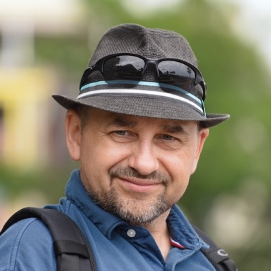Spectroscopy of Deception
Unmasking Food Fraud with Biophysics
Bartek Rajwa
Research Professor, Computational Biology and Bioinformatics
Purdue University
About the Lecture

The broadly defined concept of food fraud encompasses adulteration, substitution, dilution, tampering, misrepresentation of food, country of origin, food ingredients, and intellectual property rights counterfeiting. As food production, processing, and distribution have become increasingly interconnected globally, consumers now enjoy access to an unprecedented variety of products. However, this global expansion also increased the risk of food fraud, necessitating novel mitigation strategies. One such strategy is the use of food fingerprinting technologies, which validate food provenance, authenticity, quality, and safety and can contribute to early warning networks in cases of suspected food fraud. Food ingredient monitoring and fingerprinting is a well-understood idea known for its benefits. For instance, in the event of a massive outbreak of a food-borne epidemic, especially one driven by a previously unknown, newly emerging pathogen, monitoring food provenance would be the fastest and easiest way to trace the origin of the biological threat. While the concept has clear advantages and merits, its practical implementation requires a sophisticated combination of complex tools. These include biophysical and chemical analysis, statistical methods, data processing, and machine learning techniques. Additionally, the proposed solutions must balance requirements regarding cost, portability, and ease of use. This presentation will showcase some of the biophysical optical techniques that have been employed for the purpose of food authentication and fraud detection. Furthermore, it will explore how the fusion of biophysical analysis with the latest machine learning innovations can realize the full potential of food fingerprinting, marking a significant leap forward in our fight against food fraud.
Selected Reading
• Using a Food’s Unique Fingerprint to Detect Fraud by Emily Baron Cadloff https://modernfarmer.com/2023/10/foods-fingerprint-fraud/
• Stopping knockoff knockwurst and phony fromage. How the food industry is stepping up anti-fraud technology by Laura Reiley, https://www.washingtonpost.com/business/2023/10/12/food-fraud-cheese-technology/
• Hellberg, R. S., Everstine, K., & Sklare, S. A. (2021). Food fraud: A global threat with public health and economic consequences. Academic Press. https://www.sciencedirect.com/book/9780128172421/food-fraud
About the Speaker

Bartek Rajwa received his education from Jagiellonian University in Kraków, Poland. Since 2002, he has been continuously affiliated with Purdue University in Indiana, USA, initially as a research scientist and later as a faculty member. Bartek currently serves as a Research Professor of Computational Life Sciences and Bioinformatics at the Bindley Bioscience Center, Purdue University. His expertise is rooted in the rapidly evolving field of biological data science, encompassing bioinformatics, biostatistics, and multi-omics data analysis. This interdisciplinary field aims to synthesize information from various advanced life sciences measurement technologies, including proteomics, metabolomics, genomics, biological imaging, lipidomics, and cytometry. In his research, Bartek applies mathematics, computer science, and machine learning to unravel and interpret complex phenotypic patterns observed through quantitative single-cell analysis. His work, which focuses on automated phenotype classification in the presence of incomplete and noisy data, significantly impacts areas like clinical cytometry (hematology, immunology, oncology), high-content screening, drug discovery, toxicology, neuroscience, and agriculture (emphasizing food fraud detection, biosecurity, and biosurveillance). Bartek has co-developed several groundbreaking technologies alongside fellow researchers. These innovations include spectral flow cytometry, automated clinical flow cytometry analysis pipelines, algorithms for food-borne pathogen identification, and advanced spectral information processing methods for cytometry and imaging. Bartek is the Editor-in-Chief of Cytometry Part A: Journal of Quantitative Cell Science, an official publication of the International Society for Advancement of Cytometry.
Minutes
On February 9th, 2024, in the Powell Auditorium of the Cosmos Club in Washington, D.C., President Larry Millstein called the 2,490th meeting of the Society to order at 8:04 p.m. ET. He began by welcoming attendees, thanking sponsors for their support and announcing new members. Scott Mathews then read the minutes of the previous meeting including the lectures by Lloyd Mitchell, Ajay Kothari, and Scott Mathews. The minutes were approved as read.
President Millstein then introduced the speaker for the evening, Bartek Rajwa, of Purdue University. His lecture was titled “Spectroscopy of Deception: Unmasking Food Fraud with Biophysics”.
The speaker began by comparing the USDA and FDA definition of food fraud with those of the European Union, indicating that food fraud is taken “way more seriously in Europe”. He stated a useful definition as “fraudulent, intentional substitution or addition of a substance in a product for the purpose of increasing the apparent value of the product or reducing the cost of its production, i.e. for economic gain.” He listed the commonly adulterated food products as: oils, milk, juices, spices, sweeteners, seafood, and grains/cereals.
Rajwa then recounted a recent scandal in the United States where large quantities of ground “Parmesan Cheese” were found to comprise primarily old Cheddar cheese (old, not aged) and wood pulp. He then discussed the 2013 horse meat scandal in the UK, where large quantities of ground beef were contaminated with horse meat. Rajwa detailed the circuitous route the adulterated meat had taken: starting in Poland, shipped to the Netherlands and Spain for processing, then shipped to Ireland, where it was ultimately sold to UK retailers. In the end, however, the source of the horse meat turned out to be Canada. The speaker used this example to highlight the way that global trade can make it difficult to identify the source of food fraud.
Rajwa then made the distinction between intentional adulteration and unintentional or accidental adulteration, and the way such adulteration impacts food fraud, food quality, and food safety. He said that in the US, the cost of food fraud is estimated at $10 to $15 billion annually, and in the EU, the cost is estimated at €8 to €12 billion.
The speaker then introduced optical and spectroscopic techniques that can be used to identify food fraud, including laser induced breakdown spectroscopy or LIBS and vibrational & fluorescence spectroscopy or Raman, both of which can easily be miniaturized. In LIBS, a very powerful laser is used to heat a small volume of matter, which becomes a plasma and emits light characteristic of the atoms in the plasma plume. This light is collected by a fiber-optic cable and analyzed with a spectrometer. In Raman spectroscopy laser light scatters off molecules and a small number of photons transfer energy to the molecule resulting in a change of the photon’s wavelength. Again, the scattered light is collected by a fiber-optic cable and analyzed with a spectrometer. The shift in the wavelength of the photon is characteristic of specific molecular bonds, and therefore indicative of the presence of specific molecules.
Rajwa then compared the pros and cons of LIBS and Raman, arguing that these two techniques can be combined into a single instrument capable of creating a chemical fingerprint for complex organic mixtures. He showed LIBS and Raman spectra from a variety of food products in different forms: for solids; cheese and coffee beans, for liquids; Balsamic vinegar and vanilla extract, and for powders: several ground spices. Rajwa commented on the complexity of these data and discussed various techniques for analyzing and identifying the spectra. He indicated that the most common spectral analysis technique used by his group was a simple, machine learning algorithm which included normalization, linear model feature selection, classification using regularized regression, and validation. He then presented some of the mathematical details of this analysis, showing how it could extract the most reliable peaks for each of the food products analyzed.
Rajwa then showed how these techniques could be used to identify trace quantities of pesticides and how known information concerning the global use of pesticides could be used to identify the country of origin of the food products. He concluded his talk by reiterating the fact the that Raman and LIBS are complementary techniques that are easily combined to form a portable, handheld system for analyzing food products. He said that while the current systems have been used for laboratory demonstration, the future commercialization and deployment of such systems will serve to enhance food safety and reduce food fraud.
The lecture was followed by a Question and Answer session.
One member stated that “This is an important topic because everyone eats food”, and asked whether these techniques would allow consumers to know with certainty if food labelled as organic was actually organic. Rajwa responded that terms like “organic” and “sustainable” were not very well defined and not well regulated. He said that determining whether a given product meets the criterion for being labelled as organic or sustainable would require stricter definitions of the terms. He commented on the fact that organic foods have a notoriously bad record in terms of food borne pathogens.
A member asked about the applicability of this technology to engineered food. Rajwa responded by first making the distinction between bio-engineered vs. engineered food products. For bio-engineered foods, or genetically modified organisms, he said that genetic testing could reveal the presence of genetically modified products. For engineered foods, which he defined as being either grown in a laboratory or heavily processed, he said that these spectroscopic techniques would be ideal, because it is extremely difficult to reproduce the natural ratios of various compounds.
A viewer of the live-stream asked if local authorities were using techniques such as Raman and LIBS to detect food fraud in restaurants, particularly with respect to seafood substitutions. Rajwa replied that his instruments were strictly for laboratory use, and that he hoped that such systems could be used in this scenario in the future.
After the question and answer period, President Millstein thanked the speaker and presented him with a PSW rosette, a signed copy of the announcement of his talk, and a signed copy of Volume 1 of the PSW Bulletin. He then announced speakers of up-coming lectures, made a number of housekeeping announcements, and invited guests to join the Society. He adjourned the 2490th meeting of the society at 10:04 pm ET.
Temperature in Washington, DC: 10.6° Celsius
Weather: Mostly cloudy
Audience in the Powell auditorium: 41
Viewers on live stream: 30 …for a total of 71 live viewers
Views of the video in the first two weeks: 329
Respectfully submitted, Scott Mathews: Recording Secretary